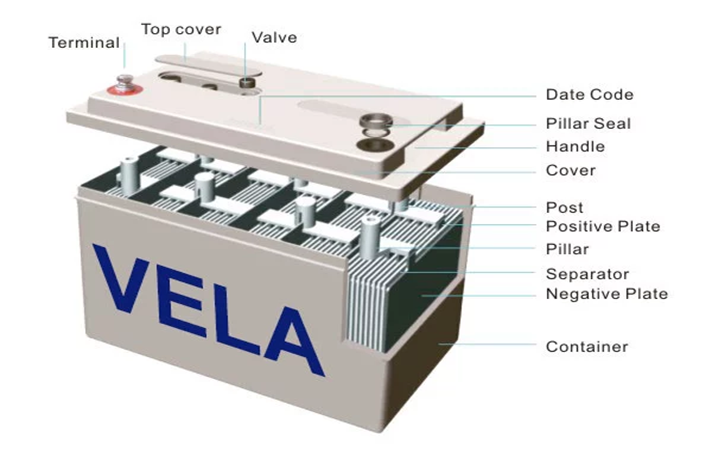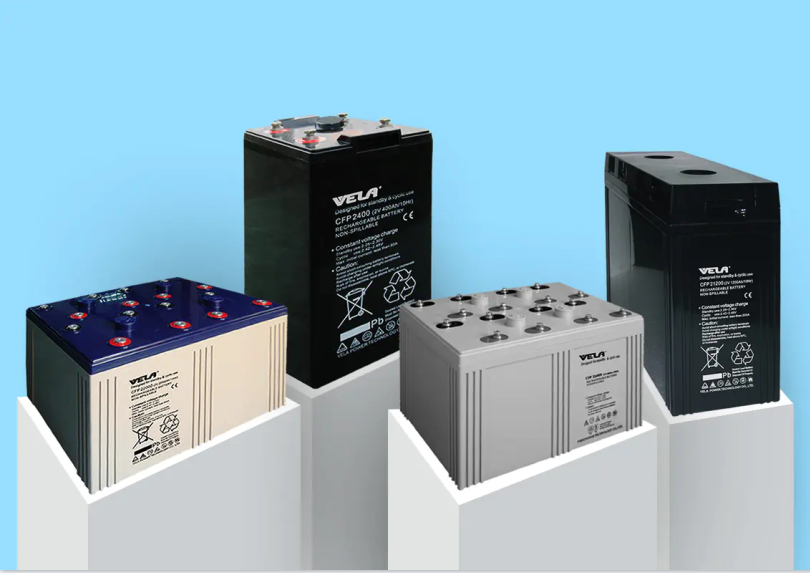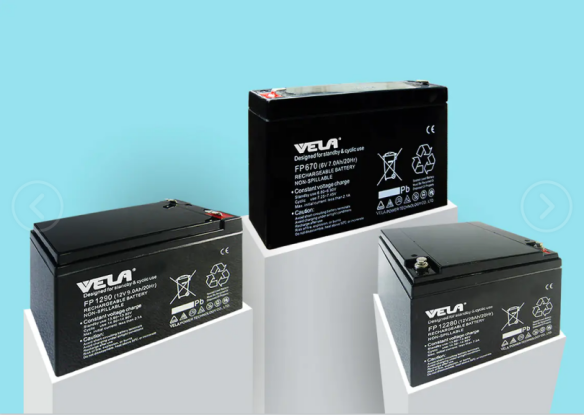
1.what is Valve Regulated lead acid battery
A valve regulated lead–acid (VRLA) battery, which is a type of rechargeable battery commonly known as a sealed lead–acid (SLA) battery, or maintenance-free batteries.VRLA battery is the most popular reserve power design because the electrolyte is captive, preventing it from spilling even when the case is punctured. It was invented in the 1970s. By 1975, a large scale of production had been formed in some developed countries, and it was soon industrialized and put on the market in large numbers. Although this battery is also a lead-acid battery, it has many advantages compared with the original lead-acid battery, and it is very popular with users, especially for those who need to install battery supporting equipment together (or a workshop). , Such as UPS, telecommunications equipment, mobile communication equipment, computers, motorcycles, etc. Because VRLA batteries are fully sealed, no acid leaking, and will not release acid mist when charging and discharging like the traditional lead-acid batteries, which will corrode equipment and pollute the environment, so people call VRLA batteries in terms of structural characteristics.
 2.How do VRLA battery work?
A lead-acid battery is made of lots of lead-acid cells wired in series in a single container. Lead-acid cells have two plates of lead hung in a fluid-like electrolyte solution of sulfuric acid. While in use, the battery generates power by reducing the lead plates, turning them into lead-sulfuric-oxide. This process is reversed once the battery is charged – meaning the lead-sulfuric-oxide is broken down turning it into pure lead and sulfuric acid. Since this reverse process is not perfect, hydrogen gas is released before it can completely mix with the water inside the battery container. To prevent the build-up of hydrogen gas (which may cause the battery to explode), a vent is used to relieve the pressure. To avoid these problems, valve regulated lead-acid (VRLA) batteries prevent the movement of the electrolyte inside the container, trapping the hydrogen near the plates, making them readily available for re-combination as the battery is recharged.
2.How do VRLA battery work?
A lead-acid battery is made of lots of lead-acid cells wired in series in a single container. Lead-acid cells have two plates of lead hung in a fluid-like electrolyte solution of sulfuric acid. While in use, the battery generates power by reducing the lead plates, turning them into lead-sulfuric-oxide. This process is reversed once the battery is charged – meaning the lead-sulfuric-oxide is broken down turning it into pure lead and sulfuric acid. Since this reverse process is not perfect, hydrogen gas is released before it can completely mix with the water inside the battery container. To prevent the build-up of hydrogen gas (which may cause the battery to explode), a vent is used to relieve the pressure. To avoid these problems, valve regulated lead-acid (VRLA) batteries prevent the movement of the electrolyte inside the container, trapping the hydrogen near the plates, making them readily available for re-combination as the battery is recharged.
 3.What are the types of VRLA battery?
There are two types of VRLA Batteries: the Gel Cell and the Absorbed Glass Mat (AGM).
Gel Cell Battery – As its name suggests, the Gel Cell Battery has an immobile jelly-like electrolyte where the sulfuric acid is mixed with fumed (pyrogenic) silica used as a thickening agent. Absorbed Glass Mat Battery (AGM) – In this type of battery, the acid is absorbed and immobilized by very thin fibreglass mats between the plates. This construction makes the acid readily available to the plates and allows a quick reaction between the acid and plate material.
AGM Batteries are the perfect choice for motorcycles and ATVs. Deep-cycle AGMs are also commonly used in off-grid solar power and wind power installations, our company has been engaged in producing AGM batteries for many years. AGM batteries are widely used in the field of motorcycles and solar systems. If you are interested, welcome to send us inquiries anytime.
3.What are the types of VRLA battery?
There are two types of VRLA Batteries: the Gel Cell and the Absorbed Glass Mat (AGM).
Gel Cell Battery – As its name suggests, the Gel Cell Battery has an immobile jelly-like electrolyte where the sulfuric acid is mixed with fumed (pyrogenic) silica used as a thickening agent. Absorbed Glass Mat Battery (AGM) – In this type of battery, the acid is absorbed and immobilized by very thin fibreglass mats between the plates. This construction makes the acid readily available to the plates and allows a quick reaction between the acid and plate material.
AGM Batteries are the perfect choice for motorcycles and ATVs. Deep-cycle AGMs are also commonly used in off-grid solar power and wind power installations, our company has been engaged in producing AGM batteries for many years. AGM batteries are widely used in the field of motorcycles and solar systems. If you are interested, welcome to send us inquiries anytime.
 4.The maintenance of VRLA battery is very important.
For VRLA batteries, only when the strict operation is carried out according to the manufacturer’s requirements, will the life of VRLA batteries be truly close to their design life, otherwise, the life of the battery will be shorter than that of ordinary batteries.
4.1,Pay attention to the environmental temperature.
In actual operation, VRLA batteries have relatively high requirements for environmental temperature, and the best environmental temperature for VRLA batteries is 20-25°C. If the operation of environmental temperature is too high, the generated heat during charging of the VRLA battery cannot be diffused into the air in time, which accelerates the loss of electrolyte, and at the same time, it is easy to lose water through the shell, resulting in an accelerated increase in the specific gravity of the electrolyte. The corrosion of the positive grid eventually leads to the premature failure of the VRLA battery before reaching the battery design life.
4.2.Pay attention to the floating charge voltage.
Normally, the floating voltage should be adjusted in time according to the operating conditions of the battery and charging equipment make the float voltage meet the requirements of the VRLA battery to avoid excessive voltage and cause the loss of moisture due to overcharging of the battery; at the same time, we should prevent the voltage being undercharged of the VRLA battery from causing the sulfation of the battery plates, which greatly reduces the battery capacity.
In order to test the status of the VRLA battery, the capacity of the VRLA battery should be checked regularly to take corresponding maintenance measures in time.in this way, the VRLA battery is always in good operating condition.
4.The maintenance of VRLA battery is very important.
For VRLA batteries, only when the strict operation is carried out according to the manufacturer’s requirements, will the life of VRLA batteries be truly close to their design life, otherwise, the life of the battery will be shorter than that of ordinary batteries.
4.1,Pay attention to the environmental temperature.
In actual operation, VRLA batteries have relatively high requirements for environmental temperature, and the best environmental temperature for VRLA batteries is 20-25°C. If the operation of environmental temperature is too high, the generated heat during charging of the VRLA battery cannot be diffused into the air in time, which accelerates the loss of electrolyte, and at the same time, it is easy to lose water through the shell, resulting in an accelerated increase in the specific gravity of the electrolyte. The corrosion of the positive grid eventually leads to the premature failure of the VRLA battery before reaching the battery design life.
4.2.Pay attention to the floating charge voltage.
Normally, the floating voltage should be adjusted in time according to the operating conditions of the battery and charging equipment make the float voltage meet the requirements of the VRLA battery to avoid excessive voltage and cause the loss of moisture due to overcharging of the battery; at the same time, we should prevent the voltage being undercharged of the VRLA battery from causing the sulfation of the battery plates, which greatly reduces the battery capacity.
In order to test the status of the VRLA battery, the capacity of the VRLA battery should be checked regularly to take corresponding maintenance measures in time.in this way, the VRLA battery is always in good operating condition.
 2.How do VRLA battery work?
A lead-acid battery is made of lots of lead-acid cells wired in series in a single container. Lead-acid cells have two plates of lead hung in a fluid-like electrolyte solution of sulfuric acid. While in use, the battery generates power by reducing the lead plates, turning them into lead-sulfuric-oxide. This process is reversed once the battery is charged – meaning the lead-sulfuric-oxide is broken down turning it into pure lead and sulfuric acid. Since this reverse process is not perfect, hydrogen gas is released before it can completely mix with the water inside the battery container. To prevent the build-up of hydrogen gas (which may cause the battery to explode), a vent is used to relieve the pressure. To avoid these problems, valve regulated lead-acid (VRLA) batteries prevent the movement of the electrolyte inside the container, trapping the hydrogen near the plates, making them readily available for re-combination as the battery is recharged.
2.How do VRLA battery work?
A lead-acid battery is made of lots of lead-acid cells wired in series in a single container. Lead-acid cells have two plates of lead hung in a fluid-like electrolyte solution of sulfuric acid. While in use, the battery generates power by reducing the lead plates, turning them into lead-sulfuric-oxide. This process is reversed once the battery is charged – meaning the lead-sulfuric-oxide is broken down turning it into pure lead and sulfuric acid. Since this reverse process is not perfect, hydrogen gas is released before it can completely mix with the water inside the battery container. To prevent the build-up of hydrogen gas (which may cause the battery to explode), a vent is used to relieve the pressure. To avoid these problems, valve regulated lead-acid (VRLA) batteries prevent the movement of the electrolyte inside the container, trapping the hydrogen near the plates, making them readily available for re-combination as the battery is recharged.
 3.What are the types of VRLA battery?
There are two types of VRLA Batteries: the Gel Cell and the Absorbed Glass Mat (AGM).
Gel Cell Battery – As its name suggests, the Gel Cell Battery has an immobile jelly-like electrolyte where the sulfuric acid is mixed with fumed (pyrogenic) silica used as a thickening agent. Absorbed Glass Mat Battery (AGM) – In this type of battery, the acid is absorbed and immobilized by very thin fibreglass mats between the plates. This construction makes the acid readily available to the plates and allows a quick reaction between the acid and plate material.
AGM Batteries are the perfect choice for motorcycles and ATVs. Deep-cycle AGMs are also commonly used in off-grid solar power and wind power installations, our company has been engaged in producing AGM batteries for many years. AGM batteries are widely used in the field of motorcycles and solar systems. If you are interested, welcome to send us inquiries anytime.
3.What are the types of VRLA battery?
There are two types of VRLA Batteries: the Gel Cell and the Absorbed Glass Mat (AGM).
Gel Cell Battery – As its name suggests, the Gel Cell Battery has an immobile jelly-like electrolyte where the sulfuric acid is mixed with fumed (pyrogenic) silica used as a thickening agent. Absorbed Glass Mat Battery (AGM) – In this type of battery, the acid is absorbed and immobilized by very thin fibreglass mats between the plates. This construction makes the acid readily available to the plates and allows a quick reaction between the acid and plate material.
AGM Batteries are the perfect choice for motorcycles and ATVs. Deep-cycle AGMs are also commonly used in off-grid solar power and wind power installations, our company has been engaged in producing AGM batteries for many years. AGM batteries are widely used in the field of motorcycles and solar systems. If you are interested, welcome to send us inquiries anytime.
 4.The maintenance of VRLA battery is very important.
For VRLA batteries, only when the strict operation is carried out according to the manufacturer’s requirements, will the life of VRLA batteries be truly close to their design life, otherwise, the life of the battery will be shorter than that of ordinary batteries.
4.1,Pay attention to the environmental temperature.
In actual operation, VRLA batteries have relatively high requirements for environmental temperature, and the best environmental temperature for VRLA batteries is 20-25°C. If the operation of environmental temperature is too high, the generated heat during charging of the VRLA battery cannot be diffused into the air in time, which accelerates the loss of electrolyte, and at the same time, it is easy to lose water through the shell, resulting in an accelerated increase in the specific gravity of the electrolyte. The corrosion of the positive grid eventually leads to the premature failure of the VRLA battery before reaching the battery design life.
4.2.Pay attention to the floating charge voltage.
Normally, the floating voltage should be adjusted in time according to the operating conditions of the battery and charging equipment make the float voltage meet the requirements of the VRLA battery to avoid excessive voltage and cause the loss of moisture due to overcharging of the battery; at the same time, we should prevent the voltage being undercharged of the VRLA battery from causing the sulfation of the battery plates, which greatly reduces the battery capacity.
In order to test the status of the VRLA battery, the capacity of the VRLA battery should be checked regularly to take corresponding maintenance measures in time.in this way, the VRLA battery is always in good operating condition.
4.The maintenance of VRLA battery is very important.
For VRLA batteries, only when the strict operation is carried out according to the manufacturer’s requirements, will the life of VRLA batteries be truly close to their design life, otherwise, the life of the battery will be shorter than that of ordinary batteries.
4.1,Pay attention to the environmental temperature.
In actual operation, VRLA batteries have relatively high requirements for environmental temperature, and the best environmental temperature for VRLA batteries is 20-25°C. If the operation of environmental temperature is too high, the generated heat during charging of the VRLA battery cannot be diffused into the air in time, which accelerates the loss of electrolyte, and at the same time, it is easy to lose water through the shell, resulting in an accelerated increase in the specific gravity of the electrolyte. The corrosion of the positive grid eventually leads to the premature failure of the VRLA battery before reaching the battery design life.
4.2.Pay attention to the floating charge voltage.
Normally, the floating voltage should be adjusted in time according to the operating conditions of the battery and charging equipment make the float voltage meet the requirements of the VRLA battery to avoid excessive voltage and cause the loss of moisture due to overcharging of the battery; at the same time, we should prevent the voltage being undercharged of the VRLA battery from causing the sulfation of the battery plates, which greatly reduces the battery capacity.
In order to test the status of the VRLA battery, the capacity of the VRLA battery should be checked regularly to take corresponding maintenance measures in time.in this way, the VRLA battery is always in good operating condition. 


